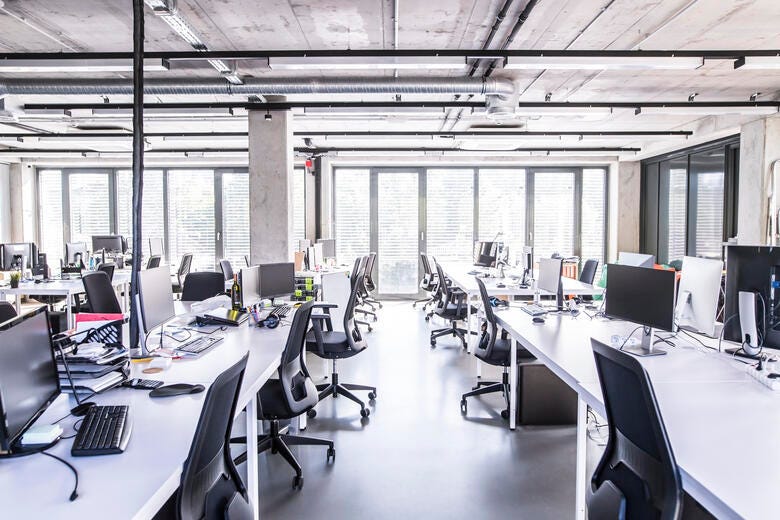
The Office Sector’s Long and Bumpy Ride Ahead
- Published
- Jun 28, 2023
- By
- Joseph Rubin
- Share
The foremost goal of real estate investors in 2023 is to find clarity in the morass of higher interest rates, falling property values, inflation-driven operating costs, and retreating lenders. Only that clarity will bolster the confidence of fresh capital as the industry adapts to a new investment environment. As we reported at the end of the first quarter, the clarity and certainty we seek remains elusive. Ironically, the only segment on which we can now shine a sharper lens is office. While at the beginning of the year many felt more optimistic about the prospects for an office comeback in many markets, the reality of a structural shift in demand grows clearer with each new headline about decreasing absorption and increasing loan defaults. This article synthesizes the pivotal trends in the sector. While office performance isn’t homogenous across markets and properties, we are still early in what is likely to be years of challenges for office owners and their investors.
All investments, irrespective of which corner of the economy they represent, will succeed or fail based on supply and demand. Real estate is no exception and remains highly cyclical. Sometimes our busts come after a period of too much building – every developer and their lenders jumping in at the same time – or a change in the need for or use of a particular type of property. Much has been written about the elongated down cycle in retail, where the supply-demand imbalance now appears to be finding its equilibrium after its own long journey. The United States was hugely overstored at the same time consumer behaviors were changing, both in their delight with online shopping and their increasing preference for experiences rather than the typical stuff found in malls.
The office sector is vulnerable to the same cyclical supply-demand imbalances that have always driven cash flows, valuations, and investor profits and losses through the years. Luckily, this time around oversupply is not an issue. But the behaviors of office consumers have changed at the same time interest rates have risen, creating a significant misalignment of supply and demand.
Yet Another Office Cycle
We’ve seen this movie before. Recall the “see-through cities” of the early 1990s when office towers were being built with no regard for demand and stood empty for years? At the time, it was projected that a decade was required to fill the vacancies, but a strong economy, job growth, and migration patterns created demand that restored equilibrium sooner than expected. Today, we face a reduction in demand rather than a profusion of new supply, although the current construction pipeline certainly isn’t helping in certain markets. According to CBRE, the 147 million of square feet of new office space delivered since the beginning of 2020 in combination with the pandemic-induced reduction in demand caused a 5.5% increase in the national office vacancy rate. Of course, there is continued demand for new, high-quality buildings that offer tenants better designs and amenities. But this new competition will be particularly impactful on older, outdated properties, which comprise the majority of the office stock in the country.
The On-Going Quest to Rent Less Office Space
For over a generation, the tug of war between job growth and more efficient space utilization has driven the ups and downs of office demand, and job growth has typically been the winner. That has now changed. Tenants always want to reduce their occupancy cost. The average square footage per person has dropped by half over the years, and accelerated in the last decade with the trend toward co-working, collaborative space designs, and hoteling. Those big corner offices with conference tables (I confess I miss mine) are nearing extinction, as is having your own personal space to display the family pictures. To squeeze as many people into a building as possible and not make it feel like a New York City subway car, you need to knock down the walls and create open areas with plenty of light. In most businesses, technology has dramatically reduced the need for paper, eliminating endless rows of file cabinets, and requiring less drawers and therefore fewer large, traditional desks. All these trends have contributed t lower demand for space.
On the other side is our resilient economy, and particularly job growth. While the number of jobs goes up and down based on many factors, including the shock of the pandemic, the U.S. has added almost 20 million jobs in the last decade. That employment growth has been the critical fuel for office demand (as well as demand for most other property types), but in the last few years the tight relationship between job growth and space demand has been severed. According to Moody’s Analytics, while two million office jobs were added since the first quarter of 2020, office occupancy dropped from 83% to 81%. Working from home is the culprit.
The jury is still out on the long-term impact of work from home, and the numbers of remote workers continues to drop. Per JLL, the number of remote job postings on LinkedIn has been cut in half in the last year. Thankfully, employees are no longer citing health concerns to stay at home; instead, many still demand the ability to live where they want, avoid a commute, and, unfortunately, not be part of an in-person office environment. In turn, more companies have realized the negative impact of work from home on corporate culture, teaming and collaboration, and mentoring and training, and are requiring employees to return to the office at least some of the time. This hybrid work arrangement is a structural change in office demand that will reduce the need for office space more than any of the cost savings initiatives of the last generation.
The CBRE Spring 2023 Office Occupier Sentiment Survey indicated that 65% of companies require employees to be in the office some days, double from a year ago, with 75% requiring at least half time in the office. At the same time, two thirds of respondents have seat sharing arrangements in their offices, recognizing that working in the office full time isn’t likely in the near future and also being more efficient with their space utilization. As a result, 68% of respondents expect to reduce their office space.
Challenging Times for Owners
The new supply-demand imbalance in the office sector has had an immediate impact, yet it will take several years for the new reality to be fully felt by owners and investors. As in all downturns, product differentiation becomes critical, separating the winners from the losers. Tenants are reducing footprints by subletting existing space and moving to new, higher quality buildings. A recent Co-Star report confirmed that the size of new leases is trending downward and that, in 2022, 84% of all new leases were in Class A buildings. The older, less well designed and amenitized properties, which represent the majority of office buildings across the country, are already being left behind.
Co-Star reports that vacancies are up in every market; there are no safe havens. National vacancy rates range between 16% and 20%, depending on which report you believe. According to JLL, the top 54 markets had an aggregate vacancy of 20.2% at the end of the first quarter, with Dallas, Connecticut’s Fairfield County, Houston, New Jersey, and San Francisco breaching 25%, and Los Angeles just a hair behind. Per Moody’s, while San Francisco had the highest increase in vacancy since the start of the pandemic, second and third place went to Austin and Charlotte, two previously booming Sun Belt markets. In other words, the problem is pervasive. Only eight out of the 54 markets had vacancy rates below 15%, with the lowest being West Palm Beach at 10.3%. Most market pundits believe that vacancy will get worse before it gets better.
But vacancy is only part of the problem because a growing portion of occupied space is on the sublet market. Per Co-Star, sublet space across the country has reached 250 million square feet, double the amount in the first quarter of 2020. That’s about 5% of the nation’s office stock. According to CBRE, 23% of available sublet space is in the technology industry, which is not surprising given Meta and Google alone have sublet millions of square feet of space. These vacancy trends are clearly putting the power in the hands of tenants.
Asking rents are holding in many markets, but of course they don’t reflect realized net effective rents. Concessions are up across the country, and inflation and increasing tenant requirements have boosted tenant improvement costs. That means while leasing activity is picking up in certain markets, a deeper dive is required to fully understand the economics of those leases. Let’s say the average national office rent is about $55/SF and on a ten-year lease the owner provides ten months free rent and a work letter of $80/SF. Amortizing the leasing costs results in a net rent of about $42/SF. Deduct operating costs of about $30/SF and the owner is left with $12/SF for debt service and investor distributions. The numbers vary by product and market, but the message is that profits on new leases are getting very thin. That’s having a big impact on debt coverage ratios, and when it’s time to refinance in this higher mortgage rate environment the lower cash flow will require a significant resizing of the loan.
The upshot is that values are falling, and we likely won’t know how much for some time. Co-Star projects that national office capitalization rates will increase from 5.5% two years ago to about 7.5%. According to the RCA CPPI Index in April, office values had fallen 6.9% from one year ago. But that statistic is based on transactions, which are few and far between. The public market has priced in more severe valuations. The S&P Office REIT Subindustry Index has fallen from 189 to 96 over the past year, about a 50% drop. Market participants predict that values will fall between 25% and 50%, again greatly dependent on the property, its tenancy, and location. The valuation comes to the forefront when a property is sold – and that isn’t happening very often – or when a mortgage matures. As the headlines have shown, many institutional investors have already concluded that their ownership options are no longer in the money and there will not be a sufficient return on further capital infusions.
The Lender Perspective
For lenders, office loans are the industry’s new hot potato. In a recent survey of market participants by Morrison Foerster, respondents ranked the availability of refinancing of office properties from 1 to 5, with 1 being “very unavailable.” 85% responded with a 1 or 2 rank. As interesting, in a question asking whether new lenders will refinance existing office loans, less than half felt new lenders would step in to take out the loans, and about a third felt the probability of that happening was less than 20%. That means there is serious office loan avoidance, and current lenders will likely need to restructure the debt at maturity to extend the loan and avoid losing the property. According to Moody’s Analytics, about $8 billion of CMBS office loans will mature during the rest of this year, and 84% of those loans are refinanced challenged.
These issues have recently shown up in loan performance metrics. Trepp data shows that CMBS office delinquency has increased from 1.63% in May 2022 to 4.02% in May 2023. Similarly, office loans in special servicing rose from 3.36% to 6.43% in the same period. Another leading indicator is the CMBS watch list. Based on data compiled by CREFC, 10.7% of CMBS office loans were on watch list in December 2019, 15.7% in April 2022, and 20.23% in April 2023. Office loan performance in banks and other lenders is likely exhibiting similar trends. Of course, some office loans are getting done, but with far stricter underwriting, more structure, and higher pricing. According to Commercial Mortgage Alert, spreads on office loans were 230bp over Treasury at the end of May, compared with 185bp for multifamily and industrial lending, a 45 bp premium.
Investor Action Steps
In commercial real estate challenging situations are never hopeless, just capital intensive. If the owner/investor believes their equity option in the property is still worth something, the solution may be found in repositioning the asset and/or restructuring the debt. Owners should be formalizing their action plans, which could look something like this:
- Hoard cash – if the bank isn’t already sweeping the rents, hold onto all the property’s cash flow in preparation for the loan refi or capitalintensive property improvements.
- Remodel the property’s cash flow – use realistic rent and expense assumptions to get a better picture of future performance, capital requirements, and the cash flow available for a sustainable loan restructure.
- Talk to tenants – find out what’s on their mind and start to negotiate lease extensions with economical concessions early.
- Talk to lenders – share action plans and cash flow models to convince lenders you are acting in good faith and want to sustain the loan; before you have that conversation be keenly aware of compliance or non-compliance with loan covenants.
- Consider repositioning strategies – assess the feasibility of enhancing the property to better attract tenants.
- Consider reuse strategies – if repositioning doesn’t work, assess whether the property can successfully be converted to residential or mixed use. While there has been much written about these conversions few are actually happening due to design, location, zoning, and a myriad of other issues to work through.
The challenges facing the office sector are complex and still being revealed. It has taken at least fifteen years to realign supply and demand in the retail sector, and it is likely that we are still early in the long trek ahead for office as well. Office owners must determine impact of changing demand for their space, and whether to double down on their investment or give up ownership to a new owner with a lower basis in the asset. As in all downturns, ownership will change, and sometimes to the lender. The office stock must be whittled down over a period of years, and it is likely that properties not easily converted will be demolished to make room for new development. While drastic, replacing old, obsolete product with new, productive properties will enhance the community through the next cycle. Perhaps that will be the happy ending to the long and bumpy road ahead.
What's on Your Mind?
Start a conversation with Joseph
Receive the latest business insights, analysis, and perspectives from EisnerAmper professionals.











